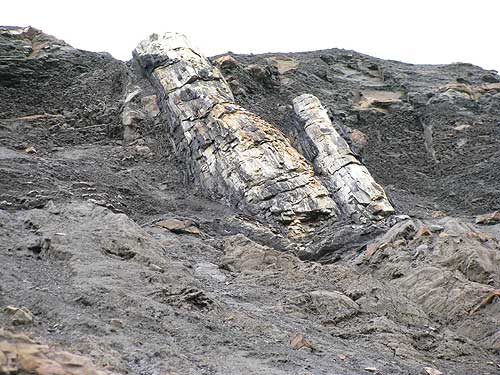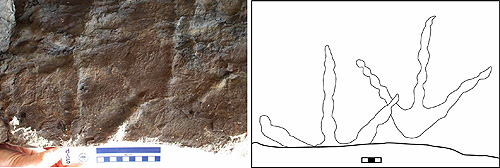
By NED ROZELL February 11, 2011
Williams, a researcher at Franklin & Marshall College in Lancaster, Pennsylvania, studies ancient forests all over the world, including the high arctic of Canada, which now only hosts willows as thick as your wrist.
The twin stems of a 55-million year old fossil tree resting in the soil near Sutton, Alaska.
In 2008, Williams and his colleague David Sunderlin of Pennsylvania’s Lafayette College traveled with six undergraduate students to an old coal mine near Sutton. There, they saw what others might have thought to be long, chunky colorful rocks, but they knew they were looking at the stumps and stems of trees that fell millions of years ago. Williams was surprised at how similar the Sutton fossil forest was to those he studied 1,200 miles farther north, where the ancient trees flourished despite seasonal periods of extended darkness and sunshine. He and Sunderlin along with their crew found that the Sutton area had hosted a lush forest of trees, such as dawn redwoods. The trees, shorter than coastal redwoods, once grew over a wide swath of the northern hemisphere, but are now only in China. Williams’ team also found many fossilized leaves at the site. “The fossil leaves in Sutton point to a mix of broadleaved deciduous plants and conifers growing in a floodplain environment surrounding a shifting stream course,” William wrote in an email. Sunderlin used those fossil leaves to calculate what the climate of southcentral Alaska might have been 55 million years ago. He figured the average annual temperature needed to support the forested swamplands was about 55 degrees Fahrenheit. Sutton’s average temperature today is about 35 degrees F. Sunderlin also estimated that the area would have to be much wetter than it is today to sustain the ancient forest. “Topographically, it may have been . . . something like the modern day Willamette River Valley in Oregon,” Williams wrote. “(It) would be a little warmer and a little wetter than the present climate of the Pacific Northwest.” Stone bird tracks in Denali About 15 million years before the redwoods of Sutton were leafing out, prehistoric birds were striding through the mud at Denali National Park. Their fossilized tracks remain, and two of the birds are different enough from other ancient species of Asia and North America that a paleontologist has given them brand-new names.
Tracks of a large, crane-like bird that walked in the Denali National Park area about 70 million years ago.
A frequent visitor to Alaska, Fiorillo has been exploring its national parks in recent years. According to him, the birds that left their tracks in Denali 70 million years ago were likely taking advantage of the northland’s abundant insects and plentiful daylight - just as cranes, sparrows, sandpipers and other migratory birds will do in the coming months. “Alaska probably served as a nesting area for at least some of the birds of both (North America and Asia) in the Cretaceous, just like it does today,” he said.
This column is provided as a public service by the Geophysical Institute, University of Alaska Fairbanks, in cooperation with the UAF research community.
Publish A Letter in SitNews Read Letters/Opinions
|

